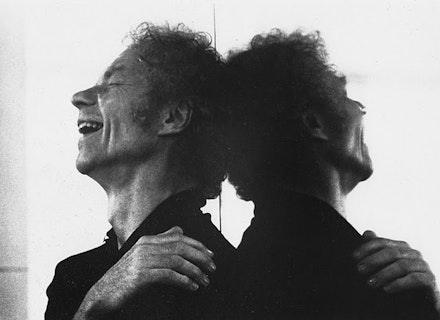Dance
Merce's Way
Centennial Notes

Nancy Dalva: Do you think that people now regard you as a guru, some kind of figure who can impart wisdom?
Merce Cunningham: [Laughs] I would doubt it.
Dalva: I wouldn't doubt it; I think John Cage had that about him.
Cunningham: Oh well John, I think, was a guru.
Dalva: But you don't think you are?
Cunningham: Uh, no. I think that I attempt to impart—in, say, the technique class—something of how I think movement not necessarily should be done but how it can be done to get the fullest possible use of any given movement. I always think that no matter how small the movement is you should do it as though it's the biggest possible movement in the world.
Dalva: But one could apply that to anything.
Cunningham: Yes, yes.
Dalva: And that would make you a guru.
Cunningham: Well, maybe.
Author's Note
Between July 2008 and June 2009, I interviewed Merce Cunningham nineteen times for the web series called Mondays with Merce. The gnomic statements shared here are all from those conversations.*
How you get into something is equally important as when you get there.
If you do something long enough, it becomes natural.
I keep trying to do things I don't know about.
Well, I wanted to make some way where things could change, because things do change. And it might as well be part of what we do rather than trying to avoid it.
Complexity is part of what we live with.
I look forward to change. If I can make something that I've always done one way and then suddenly, for some reason, by accident or whatever, it becomes something different, I'm delighted. It gives one a different experience.
I try to avoid decoration, something that's simply to make it look better than it is.
When you put your leg out it should look as though it still belongs to you.
There are certain limits to what the human body can do, but within the limits, the variety is endless.
You put two apples together, and they are apples, and they are round, and they have a certain shape. But at the same time, they're not identical.
There are so few ways to jump. There are only five. But it's what you do when you get up there that makes it different.
Mistakes are marvelous. Oh yes, it shows you something you don't know.
If you see somebody do something, even if they don't do it well, you say "Oh, I've never seen that." Then your mind lights up a little.
Rhythm is time cut up in different ways—familiar ways and most provocative when they're not familiar.
I think stillness is just as much a part of dancing as moving.
I think any movement is possible to use as choreography, certainly.
Almost anything anybody does is a gesture.
Drama? I think drama is contrast. Something has to be different from what came before, or after or whatever. Drama is contrast on any level, as far as I can see . . .
I haven't attempted to extend the idea of expression. I preferred to try to extend the idea of movement, which might become expressive in different ways to different people.
Dancing is a physical act that you deal with daily. And it's quite true that when you get older, certain things you can't do the way you did. But there are other ways to think then. And rather than not think at all, or not try at all, from my point of view it's better to try.
One day we're speeding through sunshine, and the next day we're slogging through snow. But it still is a day that you have to go through.
A dancer has to find a way to begin again each day. You just have to come again as though, not so much that you've never done it before, but come again to it as though it were something you were finding out about.
It's about how do you continue rather than simply stopping . . . I think one thing that in the theater you have to learn: That when you go off, you are exiting. Don't finish what you're doing before you're really off.
Rather than say no, which cuts something off, you can say "yes" and then find some way to do something.
Instead of saying no, we said yes, why not, and we found a way.
© Nancy Dalva 2019, from the transcripts of Mondays with Merce.

